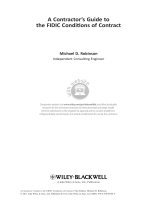A plain english guide to the local government finance settlement for 2011 12
Bạn đang xem bản rút gọn của tài liệu. Xem và tải ngay bản đầy đủ của tài liệu tại đây (48.88 KB, 9 trang )
A Plain English Guide to the Local
Government Finance Settlement for 2011-12
A Plain English Guide to the Local Government
Finance Settlement 2011-12
Introduction
The Local Government Finance Settlement determines how much grant
central Government will give to each local authority in England over the next
two years.
The Spending Review announced the total formula grant all local
authorities will receive over the next four years. The Local Government
Finance Settlement sets out how that grant will be distributed between
authorities over the next two years in a fair and sustainable way, and how
much each individual authority will receive.
This year’s settlement reflects the unprecedented economic circumstances
the nation faces. The Spending Review set out how the Government would
tackle the catastrophic levels of public debt and put the public finances back
on a sustainable footing. This has involved tough decisions throughout the
public sector. But unfortunately given our economic inheritance, these have
been essential, responsible decisions. The most recent forecasts from the
Office for Budget Responsibility confirm that we were right to take these
difficult steps. Their message is that Britain’s economic recovery is on track,
and the Government is on course to balance the books.
Now the provisional settlement has been published, there is a statutory
consultation where councils and other interested groups have the chance to
comment on the proposals. After any changes are made, the final settlement
for 2011 – 12 will be debated and approved by the House of Commons in the
new year. Legally, the Government cannot formally finalise the figures for
2012-13 at this point, but we do not expect to change the provisional
allocations except under entirely exceptional circumstances. The
Government will consult on the final 2012-13 settlement at this time next year
in the usual way.
Given the unprecedented economic circumstances for this year’s settlement,
we have made several changes to the way that grant is shared out between
authorities. This is in direct response to requests from the local government
community.
The effect of these changes is to:
• Insulate the poorest and most vulnerable areas from the most
significant formula grant reductions
• Limit the need for councils to ‘front load’ the cuts into the first year of
the settlement
In other words, without the changes that we have introduced:
• The poorest areas would be worse off relative to other areas
2
•
The reductions to councils spending power would be much more
substantial in the first year
This settlement also affirms the Government’s commitments, set out in the
Spending Review, to protecting council tax payers and to funding adult social
care.
This document explains the different features of the settlement in more detail
and includes general background details of the way local government is
funded.
Focusing resources on the most vulnerable communities
Some areas of the country are much more reliant on central government grant
than others. These tend to be more deprived communities, with more
significant social challenges. Council tax receipts in these areas are therefore
lower while the need for council services is often higher. Some areas rely on
central government for 75 per cent of their total budget: other areas which
collect more council tax and are more self-sufficient only rely on government
grants for 20 per cent of their budget.
This means that applying an equal percentage reduction (a ‘salami slice’) to
the grant would leave the poorest areas disproportionately worse off. This is
easiest to explain through an illustration: if a 10 per cent reduction to grant
was applied across the board, a council which relies on central government
grant for seventy per cent of its budget would see that budget fall by seven
per cent: while a council which only relied on government for 20 per cent of its
budget would see the budget fall by only 2 per cent. This would be
regressive, hitting the poorest areas hardest.
The Government has acted to mitigate this by changing the way that the grant
is calculated: paying more attention to the levels of need in the area, and
distributing less money per person.
In the past, Government has set a single ‘floor’ to limits the effects of changes
from year to year. This is also called ‘damping’.
Instead of just a single floor, this year councils have been grouped into four
bands with four different floors. These bands are based on the percentage of
the budget that the authority receives from central government formula grant.
By setting different floors for authorities in different circumstances,
Government has capped the reductions in grant for more needy authorities at
a lower level than more self-sufficient areas. Again, this insulates the most
dependent places from the sharper grant reductions they would otherwise
have had. This is a fairer and more progressive system than in the past.
It is also important to remember that more needy areas receive significantly
more grant per person than places which are better off. Taking into account
the financial circumstances and all the changes this year, people in Hackney
3
still receive £1043 per head, while residents in Wokingham receive only £125
per head.
Reducing the need for councils to ‘front load’ the reductions
Tackling the public deficit head on in order to achieve sustainable economic
growth is the Government’s most important priority. That has meant some
tough, but essential, decisions about the timing of the reductions. At the
same time, however, the Government recognises that councils need to
manage the impact of those reductions sensibly and effectively over the
spending review period.
Over the past few months, councils and the Local Government Association
(LGA) have expressed concerns that the reductions might have to be too
heavily ‘front loaded’ – meaning they would hit disproportionately hard in the
first year. The LGA asked the Government to tackle this by focusing on
councils ‘spending power’ rather than just formula grant. Spending power is
also made up of other government grants, NHS support for health and social
care, and council tax receipts.
By focusing on spending power, as the LGA asked, the Government has been
able to ensure that no authority will see their spending power fall by more than
8.9 per cent in either 2011-12 or 2012-13. The average fall is 4.4 per cent in
2011-12.
In order to guarantee this, we have ‘topped up’ the amount of grant going to
councils:
•
•
With an extra £30 million in formula grant
And a further £85 million in 2011-12 and £14 million in 2012-13 shared
between the councils who would otherwise have seen the sharpest
falls in their spending power
Together, this smoothes the impact and limits the need for councils to front
load their spending reductions to the first year.
Protecting council tax payers
Hardworking families and those on fixed incomes, like pensioners, have often
found the successive increases in council tax hard to cope with. This year,
the Government has acted to protect these families by setting aside £650
million to ensure that every council can freeze council tax next year
without a knock on effect in local services. Instead, the Government will
provide councils that choose to freeze council tax with the equivalent of a 2.5
per cent increase in funding.
The Government also wants to ensure council tax payers are protected
against any authorities which choose to reject the offer and impose excessive
4
council tax rises. Through the Localism Bill, the Government plans to
introduce a power for residents to veto excessive council tax increases
through a referendum. In the meantime, the Government can take capping
action against councils who propose excessive rises.
Funding social care
The Spending Review recognises the importance of social care to hundreds
of thousands of adults of all ages, backgrounds and identities: supporting their
independence and helping them to make full and active contributions to their
communities. It also recognised the pressures on adult social care and
committed additional funding over the spending review period to protect
access to services while improving quality and outcomes. £1 billion of this is
coming from NHS funding, with the intention that this should help break down
the barriers between health and social care, offering people a more coherent,
effective service. To fund this commitment, we are directing more resources
to authorities that deliver social care, rather than the district councils who do
not have this responsibility.
Further support for local government
Despite all the changes, local government is still facing significant challenges.
The vast majority have already begun to plan how they will meet these.
To support them, the Government is driving the most radical shift in power
for a generation: giving councils a real say over the issues that matter to
local people – such as housing, planning, the local economy and the local
health services. Many of these new powers will be delivered through the
Localism Bill. To free councils to focus on the frontline, the Government has
substantially reduced the burdens of inspection, regulation, and regional
bureaucracy. This is giving councils the powers, the freedom and the
flexibility they need to tackle these challenges head on.
The Government is also giving councils much greater control over their
purse strings. In previous years, there have been many more different
funding streams and grants for different projects. This was very restrictive for
councils as it meant they had to spend their money on priorities set in
Whitehall, regardless of what their residents wanted.
The number of grants has been cut from over 100 to around a dozen. With
two exceptions (schools grant, and a new public health grant) these grants will
no longer by ring fenced. This means:
•
•
The funding system is now much simpler and more streamlined
And councils have much greater control over how they spend it – there
are no strings attached to the money in the form of grant conditions –
which means they can focus on local priorities and respond to local
needs without being hamstrung by central government requirements
5
The Government also plans to change the law so councils will able to borrow
against the proceeds of future business rates (known as tax increment
funding) in order to invest.
The Government is also providing substantial financial incentives for
councils to invest in longer term projects, such as the New Homes Bonus
available over the next four years for councils investing in new housing, and
the £1.4 billion Regional Growth Fund.
How can councils respond?
All this gives councils the ability to concentrate on what their residents want –
protecting front line services.
Many councils are already responding to this challenge by:
• Improving transparency – allowing the public to see where money is
being spent, suggesting changes; making suppliers more
competitive, and changing the culture among those entrusted with
public money
• Sharing services – to achieve greater efficiency and improved
services
• Cutting out waste – particularly in back offices
• Improving procurement practice – achieving more competitive prices
by making full use of their purchasing power
• Bringing senior pay under control – including sharing senior
managers among councils
More fundamentally, councils need to take this opportunity to radically rethink
and transform their services.
Those councils which have substantial reserves should also consider using
these to address short term costs and pressures, and invest now in order to
realise savings in the longer term. Local authorities currently have around
£10 billion in reserves, but low interest rates mean they are earning very little
interest.
To support councils in their efforts, we have set aside £200 million as a
capitalisation facility to help councils modernise: reducing back office costs so
they can focus on the front line.
What does the future of local government finance look like?
This is an inherited system of financial tax finance which is extremely
complicated and has given rise to a number of problems.
•
It makes certain areas heavily reliant on hand outs from central
government. Some depend on government for up to 75% of their total
income. This is part of the trend that has seen some areas of the
country becoming increasingly reliant on the public sector rather than
private enterprise
6
•
•
•
It stifles local innovation and weakens local accountability
It makes it difficult for councils to plan and set long term budgets
It means there is little incentive for councils to invest in their local
economy – since the rewards they would have received in the form of
increased business rates receipts simply disappear into a central pot to
be shared out by central government
So as part of the white paper on Local Growth, the Government announced a
review of business rates with the intention that in future local government will
be able to keep what they collect. The Local Government Resource Review
will begin in the New Year.
This shift in policy will set councils free from dependency on government.
Ultimately, those councils which invest and support the local economy will be
better able to finance themselves.
7
Appendix A: Local Government Finance: The
Basics
Local Government has three main sources of income:
• Grants from central government
• Council tax
• Other locally generated income – which includes things like fees
and charges for services and rents on council housing
Council tax is collected by local authorities (the ‘collecting authority’) but
certain proportions – known as ‘precepts’ – are then distributed to other
authorities – primarily the police and fire authorities. In London, there are also
precepts which fund the Greater London Authority.
On average, councils receive 53 per cent of their income from central
government grant, though this significantly varies from around 20 per cent to
around 75 per cent.
Councils spend their money on three different areas:
• Capital projects, like roads or school buildings
• Council housing
• Local public services (including pay for those delivering the
services). This includes:
o children’s services
o adult social services
o police
o fire
o highway maintenance
o environmental, protective and cultural services – which
includes things like planning, libraries and concessionary
travel
The distribution of grants for these local public services makes up the bulk of
the local government finance settlement. There are two types of grants:
•
•
‘Formula grant’ which comes with no strings attached and which
councils can spend as they see fit. Formula grant is mainly made
up of the business rates which councils collect from their local
businesses as their contribution to the cost of local public services.
This is paid into a central pool and redistributed by central
government in the finance settlement. Formula grant also includes
funding from central government, known as ‘revenue support
grant’ and money from the Home Office to fund police authorities,
called ‘principal formula Police Grant’. In 2011 – 12, formula grant is
approximately £29 billion.
Specific grants, which aren’t technically part of the settlement but
are announced at the same time to help councils plan. Excluding
schools, in 2011 – 12, these total around £7 billion, and include, for
8
example, the £1.3 billion Learning Disabilities and Health Reform
Grant.
Formula grant is based on a complex formula which takes into account
• ‘relative needs’ – which reflects factors that affect the costs of
service delivery, such as levels of deprivation or labour costs in
different areas. More needy areas will receive more formula grant.
• ‘relative resources’ - which reflects the income that councils are
able to raise locally by collecting council tax. Areas with a higher
council tax base will receive less formula grant.
• ‘central allocation’ which is shared evenly out on a ‘per capita’
basis
• The way that certain specific grants which this year have been
included in formula grant were previously allocated
• ‘Damping’ in order to limit the effect of changes from year to year
This year the Government has changed the way formula grant is calculated to
take greater account of relative needs and less account of central allocation.
The amount of formula grant each authority receives also depends on the
type of authority they are: because they have different responsibilities - not
every authority delivers every service.
Lower tier – usually “district" or "borough" councils (such as St Albans) –
smaller councils which deal with more local, community-related issues such
as waste collection, social housing and homelessness, planning (development
control), council tax collection, administration of housing and council tax
benefit.
Upper tier – or “county councils” (such as Hertfordshire) – councils covering a
larger area (several districts) responsible for higher volume services such as
education, children’s services, social services, waste disposal, etc.
Unitary councils – (such as Plymouth) are responsible for all local
government functions and services in their area.
Fire and rescue authorities – oversee the policy and service delivery of the
local fire and rescue service. Their duties include promoting fire safety,
firefighting, and dealing with road traffic accidents.
Police authority – responsible for securing efficient and effective policing of
the area through the police force.
These different types of authorities have been set different floors in this years
settlement. Full details can be found at
www.local.communities.gov.uk/finance/1112/grant.htm
9









